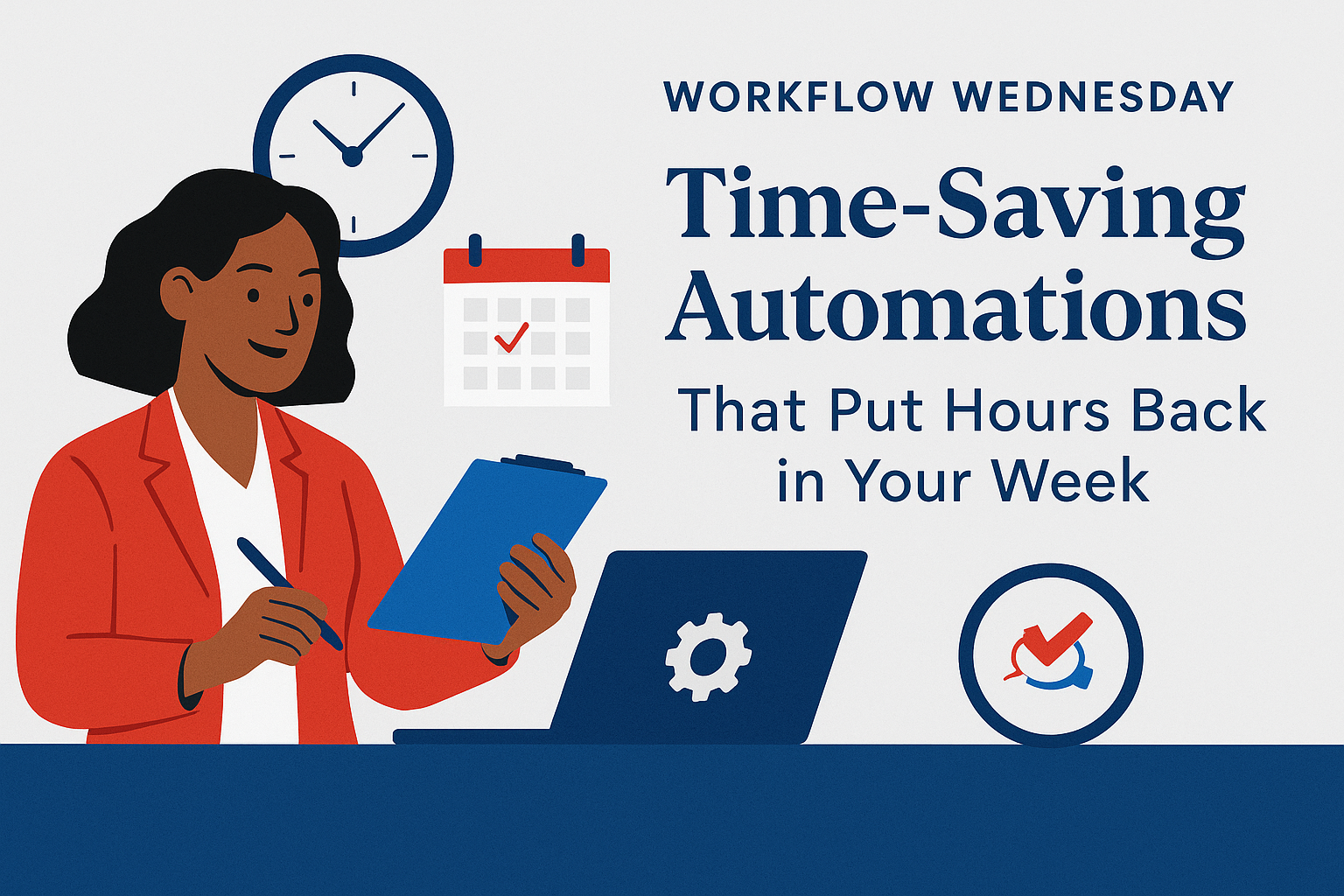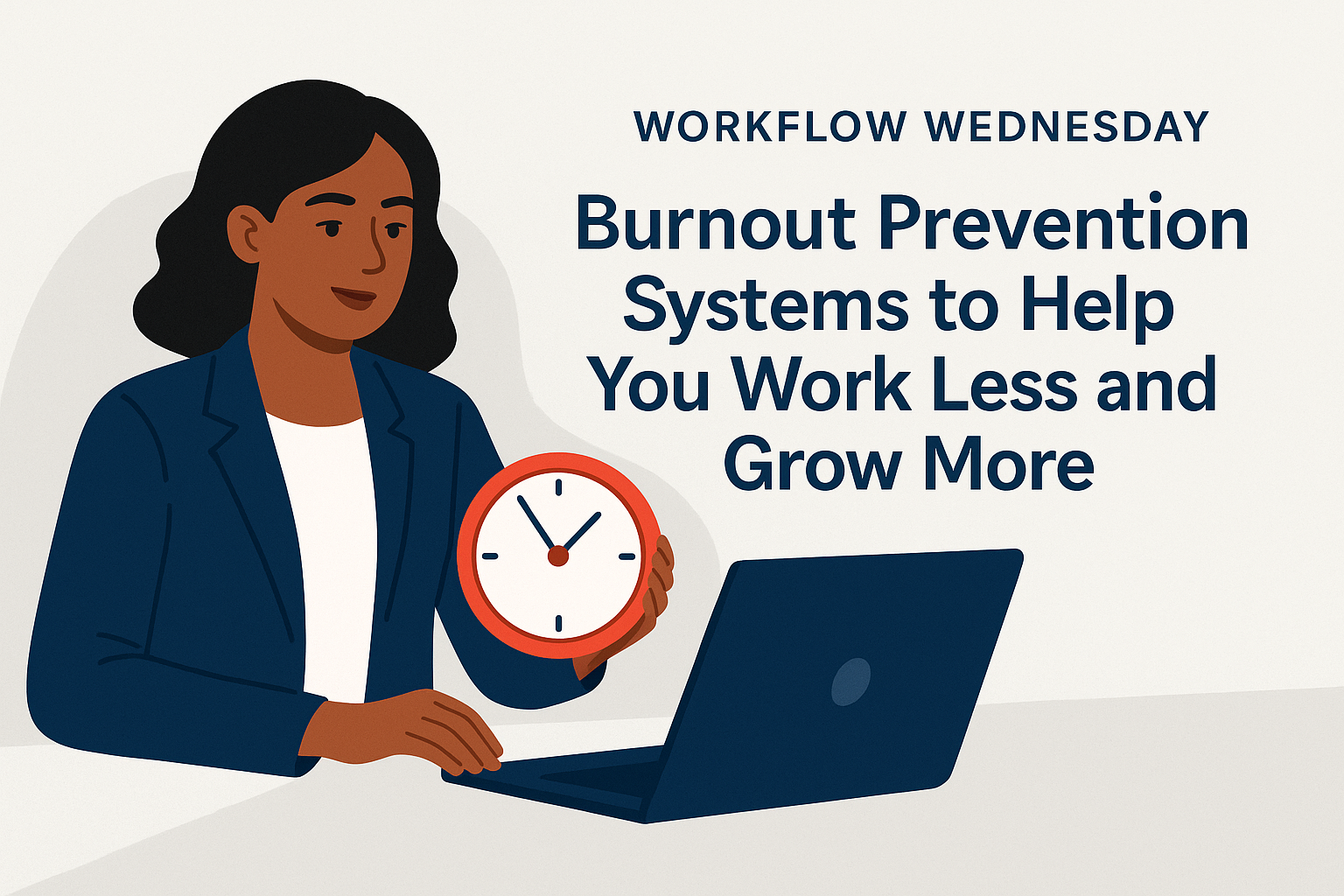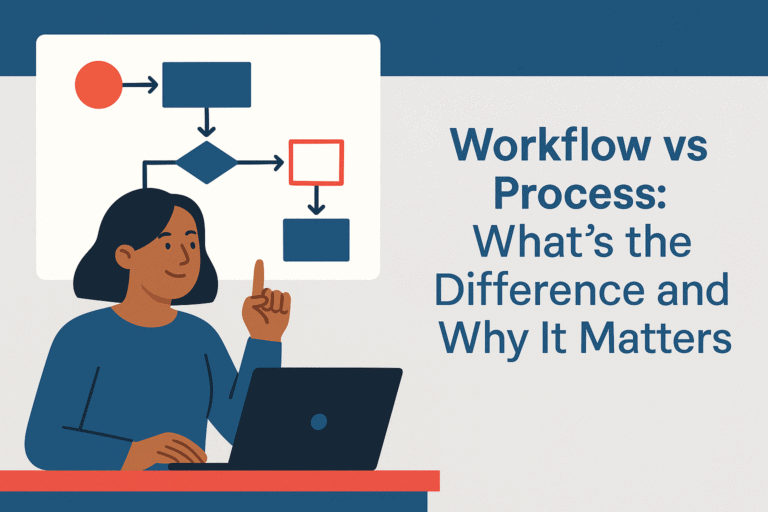As a small business owner, your time is your most valuable resource. But too often, it’s consumed by repetitive, manual tasks that don’t directly grow your business. The good news? Many of these tasks can be automated—giving you back hours every week and helping your business run more efficiently. Here are 5 tasks small businesses can automate today—even if you’re just getting started.
1. Email Responses and Follow-Ups
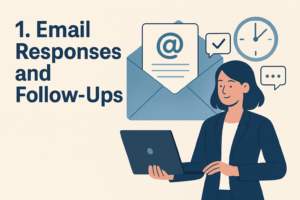
Email responses and follow-ups are one of the tasks small businesses can automate in a business. In fact, it’s a core part of my customer communication strategy and can be yours too. Whether someone submits a contact form, downloads a lead magnet, makes a purchase, or just signs up for your email list, they expect a prompt and helpful response. Without automation, this can quickly become unmanageable, especially as your business grows.
Email automation allows you to send pre-written, personalized messages automatically based on specific actions a user takes. It ensures no lead or customer falls through the cracks. It also helps you build stronger relationships without manually responding to every message.
Why automate it?
Manually replying to every inquiry, confirmation, or follow-up takes time and invites human error. Automation ensures timely, consistent communication with leads and customers, while freeing you up to focus on strategy, service delivery, or product development.
How to automate it:
Use tools like Zoho Campaigns, Mailerlite, or ConvertKit to trigger automatic email sequences based on user behavior—like a lead magnet download, purchase, or contact form submission. You can also create templates for frequently asked questions and schedule follow-up messages days or weeks in advance.
How I use it in my business:
In my own business, email automation is non-negotiable. For example, when someone signs up for one of my free guides—like the Business Startup CEO Mindset Mini-Guide—they immediately receive a branded welcome email with a download link. Over the next few days, they’re guided through a short email series. It introduces who I am, what Backbone America is all about, and how I can support them in building a business that runs without constant oversight.
This system not only saves me hours each week, it also means that new subscribers are never left wondering if their request went through. Even better, I’ve designed my sequences to segment subscribers based on what they engage with, so the follow-up emails are increasingly relevant the more they interact.
What’s powerful about this approach is that it works while I sleep, travel, or focus on client work—and it does so consistently. I don’t have to remember to follow up. The system handles that for me, ensuring leads stay warm and interested without me constantly checking my inbox.
Quick win:
Set up a welcome email series for new subscribers or customers. A simple three-part sequence can introduce your brand, deliver value, and open the door for future engagement—all without lifting a finger after the initial setup.
2. Social Media Posting

Staying visible on social media can feel like a full-time job—especially when you’re juggling everything else in your business. But showing up consistently online is essential for staying top of mind with your audience, building trust, and creating engagement. That’s where social media automation comes in.
Instead of logging in every day to post manually, you can plan and schedule content in advance. This not only ensures your audience hears from you regularly, but it also frees up time and mental energy you can use elsewhere in your business.
Why automate it?
When social media is handled in real time, it often becomes a reactive task—something you squeeze in between meetings, client work, or family obligations. That usually leads to gaps in posting or rushed content that doesn’t reflect your brand well.
Automation allows you to show up intentionally and consistently without having to be online every day. It helps maintain your presence, supports your marketing goals, and keeps your audience engaged—even when you’re focused on other things.
How to automate it:
Use tools like Zoho Social, Buffer, or Later to schedule your posts across multiple platforms like Instagram, Facebook, LinkedIn, and X (formerly Twitter). These tools allow you to upload graphics, write captions, select dates and times, and queue posts days—or even weeks—in advance. Some platforms also let you recycle or repurpose high-performing posts, so your best content continues to work for you.
How I use it in my business:
In my business, I rely on automation to keep a consistent presence across social channels, especially during busy weeks. I typically sit down once a week to schedule posts for my Backbone America accounts. I enjoy creating posts on my website, but not so much extending that love to social media. Instead, I let automations do the heavy lifting for me. It pulls content from my blog, then formats and posts it to the social media sites I think will generate the most impact..
To make sure my content stays relevant, I use keyword research tools that help me align my social posts with the topics and search terms that matter most to my business. That way, I’m not just posting for the sake of visibility—I’m sharing content that connects with the right people at the right time.
I follow up with scheduling everything with Jetpack. I can create my posts in one place without worrying about logging in to each social media site and post. This keeps my brand visible, drives traffic to my site, and creates touchpoints with my audience even when I’m working behind the scenes on course development or client projects.
Quick win:
Batch schedule one week’s worth of posts in a single session. Start with content you already have—blog excerpts, testimonials, or tips from your lead magnet—and let your automation tool take it from there.
3. Client Onboarding
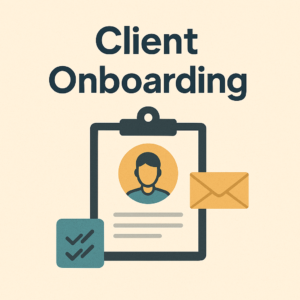
If you provide services, client onboarding can be one of the most important tasks small businesses can automate, because it’s one of the most critical stages in your business relationship. It sets the tone, builds trust, and determines how smoothly the rest of your engagement will go. When done well, it makes your clients feel welcomed, informed, and confident in their decision to work with you. When done inconsistently—or worse, forgotten altogether—it can create confusion, missed expectations, and unnecessary friction.
That’s why automating your client onboarding process is one of the smartest things you can do. It ensures that every client receives the same professional, thoughtful experience—without requiring you to recreate the wheel each time.
Why automate it?
When you’re onboarding clients manually, it’s easy to overlook key steps. You might forget to send a welcome email, delay sending intake forms, or scramble to answer the same questions over and over. These oversights can make even the best service provider seem unorganized.
By automating the onboarding process, you create a consistent, high-quality experience that reflects the professionalism of your brand. It helps you start every client relationship on the right foot, while freeing you from the repetitive, time-consuming tasks that often accompany new projects.
How to automate it:
Use tools like Zoho CRM, Dubsado, or HoneyBook to build a custom onboarding workflow. These platforms allow you to trigger automatic actions—such as sending a welcome email, collecting client details through an intake form, sharing your service guide or onboarding packet, and even sending contracts and invoices for e-signature.
You can also schedule follow-up tasks or reminders for yourself or your team, so nothing falls through the cracks. Many of these platforms integrate directly with your calendar, email, and file storage systems, streamlining the process even further.
How I use it in my business:
In my business, onboarding automation has been a game-changer—especially when handling multiple projects at once. For Done-For-You clients who purchase business plans or automation services, I use Zoho CRM to automatically trigger a welcome email that outlines what to expect, along with links to complete their onboarding form and upload any supporting documents.
Once they submit their form, it’s routed to my workspace, where I receive a task notification to begin the next phase. The automation also ensures that they receive an FAQ guide, links to schedule their kickoff call, and reminders along the way. All of this happens with little to no manual intervention from me—and clients often comment on how smooth and organized the process feels.
This not only saves me time, but it also minimizes client confusion, reduces back-and-forth emails, and shortens the time from purchase to project start. The best part? Once it’s built, it runs quietly in the background, giving each client a premium experience without extra effort.
Quick win:
Create a reusable onboarding checklist and set up a simple workflow to automatically send welcome emails and contracts as soon as someone becomes a client. Even a few small automations at this stage can elevate your professionalism and streamline your workflow significantly.
4. Appointment Scheduling
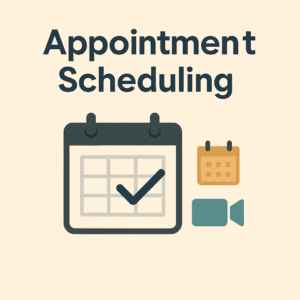
Booking appointments may seem like a small task, but the time you spend going back and forth to find a meeting time adds up quickly. Worse, that process often leads to delays, double-bookings, or no-shows—all of which can impact your client experience and revenue.
Automating your scheduling process removes the friction. It lets clients choose a time that works for them based on your availability, and it instantly confirms the meeting—no manual coordination required. Whether you’re offering free consultations, discovery calls, or client sessions, automated scheduling creates a more streamlined experience for everyone involved.
Why automate it?
Manually scheduling appointments can become a serious time-waster. It pulls you into email threads where you’re comparing calendars, suggesting times, and waiting on replies. Even when a time is confirmed, there’s still the task of creating a calendar invite and remembering to send reminders—if you even have time to.
Automation solves all of that. By using a scheduling tool, you eliminate the need for back-and-forth emails. Clients see exactly when you’re available, book a time, and receive automatic confirmation and reminders. This reduces no-shows, respects everyone’s time, and gives your business a polished, professional edge.
How to automate it:
Platforms like Calendly, Zoho Bookings, and Acuity Scheduling make it easy to build a self-service booking system. You can set your availability, buffer times, meeting lengths, and even intake questions. These tools sync with your calendar in real-time, so there’s no risk of double-booking.
Most also integrate with video conferencing platforms like Zoom and Google Meet, generating links automatically and adding them to the calendar invites. This is especially useful if you’re offering virtual consultations or running a remote business.
How I use it in my business:
Appointment scheduling automation is one of the first systems I put in place when I relaunched Backbone America. I use Zoho Bookings to manage free discovery calls and paid client sessions. When someone signs up for a service, they automatically receive my booking link—or they find it embedded on my website. From there, they choose a time, answer a few quick questions to help me prepare, and receive a confirmation email with the Zoom link already included.
Like many of the tasks small businesses can automate, you don’t have to lift a finger when it comes to bookings.
Because the system sends automatic reminders, no-shows have dropped significantly, and I leave the rescheduling to clients. It also gives clients the flexibility to book when it’s convenient for them—whether that’s during business hours or at 2 a.m. while planning their own schedule.
As far my part, I just need to keep my calendar up to date and show up for our appointments. It’s a small change that has made a huge difference in how I manage my time and serve my audience.
Quick win:
Embed your booking calendar on your website or email signature. That one small step can instantly reduce email volume and give prospective clients a faster path to working with you.
5. Invoicing and Payment Reminders
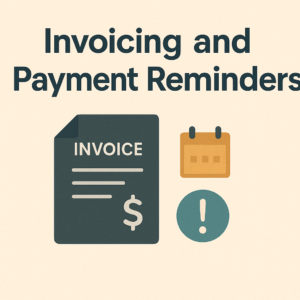
Finally, billing is another one of the tasks small businesses can automate. Getting paid on time is essential to keeping your business running smoothly. But if you’re manually creating and sending invoices—or worse, chasing down late payments—it can quickly become a source of stress and lost revenue. It’s also one of those tasks that sneaks up on you. One late invoice here, one missed follow-up there—and suddenly your cash flow takes a hit.
Automating your invoicing and payment reminders helps ensure you get paid faster, more consistently, and without the awkwardness of reminding clients to settle up. It also saves you from spending precious hours on repetitive admin work that doesn’t directly grow your business.
Why automate it?
Every minute you spend creating invoices, double-checking totals, sending reminders, or following up on overdue payments is a minute you’re not serving clients, building assets, or focusing on strategy. Worse, inconsistent invoicing practices can delay payments and give off an unprofessional impression—especially if your business is growing and you’re working with multiple clients at once.
Automation helps you streamline all of it. Invoices are sent out like clockwork, reminders go out without prompting, and your records stay organized without piles of spreadsheets and sticky notes. Most importantly, clients get a smooth, reliable experience—without you having to personally manage every transaction.
How to automate it:
Tools like Zoho Books, FreshBooks, and Wave make it easy to automate your entire invoicing workflow. You can create branded invoice templates, schedule recurring invoices, and set up automatic reminders for upcoming due dates or overdue balances.
These platforms also integrate with your bank or payment processor, so you can track payments in real-time and send receipts automatically. Some even let clients pay directly through the invoice using credit cards, ACH, or other online payment methods—making it easier for them to pay, and faster for you to get paid.
How I use it in my business:
I use a combination of WooCommerce and Zoho Books to manage all my billing—and it’s been a lifesaver. Once a client signs a contract for a Done-For-You service, I trigger an invoice from within the CRM. If it’s a one-time product, like a course, WooCommerce collects the fees before providing acces. If it’s part of a recurring package—like consulting or ongoing automation support—Zoho Books takes care of sending those invoices every month without me lifting a finger.
What I love most is the built-in payment reminders. If a payment is approaching or past due, the system sends a polite nudge automatically. I don’t have to be the “bad guy” or waste time writing follow-up emails. I also get notified when payments are received, and the system updates my records instantly, so I’m never wondering who still owes what.
This setup not only keeps my income predictable—it also helps my clients feel taken care of, because everything is clear, timely, and professional from day one.
Quick win:
Set up recurring invoices for clients you bill monthly or quarterly. Even if you’re only working with a few customers now or have no clients yet, this one step will save hours over time and protect your cash flow as your business grows.
Final Thoughts on tasks small businesses can automate
If you feel overwhelmed by your day-to-day operations, these five automations are a smart place to start. You don’t need fancy tools or a tech background to implement them. Often, the tools you’re already using have automation features baked in—you just need to turn them on.
Start small, test what works, and build from there. Your time is better spent building strategy and serving clients—not doing the same tasks small businesses can automate over and over.

